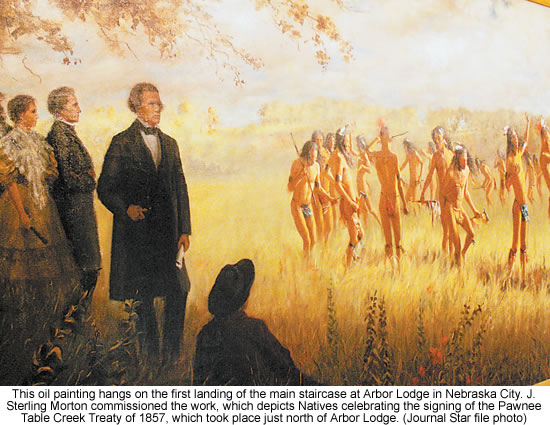 |
Canku Ota
|
 |
|
(Many Paths)
|
||
|
An Online Newsletter
Celebrating Native America
|
||
|
January 1, 2010 - Volume
8 Number 1
|
||
|
|
||
|
Painting Captures
J. Sterling Morton and Pawnee Treaty
|
||
|
by Jim McKee for the
Lincoln (NE) Journal-Star
|
||
|
In 1833, the roughly 10,000 Pawnee, who lived principally on the Loup and Platte rivers, ceded to the United States all of their land south of the Platte River, comprising "the central one third of the entire state." By 1846, most of the Pawnee had moved to new villages in Nance County. Those who remained in their old villages were brutally attacked by their long-time enemy the Sioux. A subsequent treaty on Aug. 6, 1848, ceded an 80-mile strip along the north bank of the Platte, including today's Grand Island. Conditions remained terrible, and in the summer of 1849 alone, over 1,000 Pawnee died of cholera and malnutrition. In May of 1855, a council was held with the Pawnee and Gen. John Thayer, representing Nebraska Territory. Little came of the dialogue, and by the next year the Pawnee continued suffering from the Sioux as well as constant encroachment by settlers. In early 1857, a number of Pawnee chiefs were summoned to Table Creek north of Arbor Lodge near Nebraska City by James W. Denver, commissioner of Indian Affairs. By mid September, hundreds of Pawnee had camped north of Nebraska City in anticipation of the meeting. Treaty discussions lasted five days, during which Denver stayed at Arbor Lodge in what became the home's library, later known as the Denver Room. On the final day, the treaty was signed by the chiefs, witnessed by Denver, his assistants, interpreters and J. Sterling and Caroline Morton. The gathered Pawnee engaged in such frenzied dancing that the ground was said to reverberate as far as Nebraska City, over a mile to the southeast. The treaty gave the United States the land north of the Platte River, reserving a 30 by 15 mile tract on the Loup River, the site of today's Fullerton. The Pawnee were to receive protection from the Sioux, a considerable cash grant to be paid over a number of years, an agency consisting of a sawmill, gristmill, blacksmith, gunsmith and school with teachers. The protection from the Sioux lasted only a few months, and a year later the Pawnee encountered border disputes with settlers and the Omahas. The local Indian agent, Major William Dennison, who had meantime built a large house at 10th and Laramie in Nebraska City, decided to take 12 Pawnee chiefs and four others to meet the president and introduce them to Washington, D.C. While in Washington, Chief Pe-ta-na-sharo gave a speech, noting, "All we ask is that we may go to our old home on the Loup Fork where we were driven by the Sioux." Back in Nebraska Territory, Special Indian Agent Judge J. L. Gillis, interpreter Samuel Allis, other officials and 20 Ponca chiefs examined the Mormon-established village of Genoa, which was subsequently purchased to form the promised agency and a bridge built to connect the Pawnee village and new agency. As the Sioux attacked a Pawnee buffalo hunt in 1873, near today's Trenton, it became obvious that the Pawnee could no longer remain in Nebraska. In 1876, they exchanged their remaining land in Nebraska for a site in Oklahoma. A large painting by Haskell Coffin, commissioned by Morton, hangs on the landing of Arbor Lodge's main staircase. It shows the treaty celebration and includes Denver, for whom the Colorado city was named, as well as the Pawnee and Mortons. In 1933, a stone monument was erected 1,000 feet west of the original site "under the Treaty Tree." Historian Jim McKee, who still writes with a fountain pen, invites comments or questions. Write to him in care of the Journal Star or at jim@leebooksellers.com |
|
|
||
|
|
||
| Canku Ota is a free Newsletter celebrating Native America, its traditions and accomplishments . We do not provide subscriber or visitor names to anyone. Some articles presented in Canku Ota may contain copyright material. We have received appropriate permissions for republishing any articles. Material appearing here is distributed without profit or monetary gain to those who have expressed an interest. This is in accordance with Title 17 U.S.C. Section 107. | ||
|
Canku Ota is a copyright ©
2000, 2001, 2002, 2003, 2004, 2005, 2006, 2007, 2008, 2009, 2010
of Vicki Barry and Paul Barry.
|
||
 |
 |
|
|
The "Canku
Ota - A Newsletter Celebrating Native America" web site and
its design is the
|
||
|
Copyright ©
1999, 2000, 2001, 2002, 2003, 2004, 2005,
2006, 2007, 2008, 2009, 2010
of Paul C. Barry.
|
||
|
All Rights Reserved.
|
||
 As
early as 1827, Baptist missionaries were urging the creation of
a Pawnee Agency for the tribe considered the area's prominent residents.
As
early as 1827, Baptist missionaries were urging the creation of
a Pawnee Agency for the tribe considered the area's prominent residents.